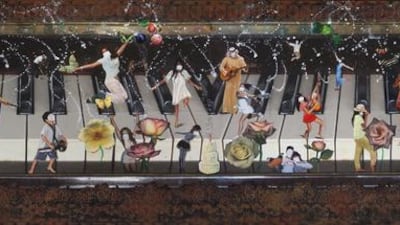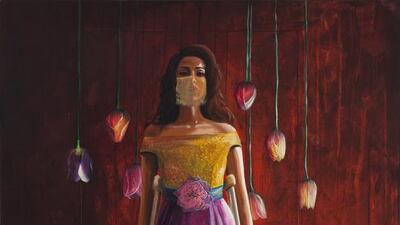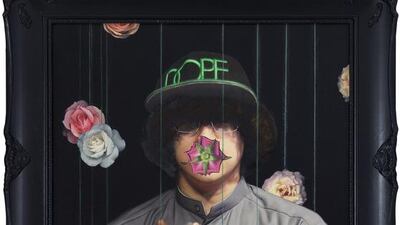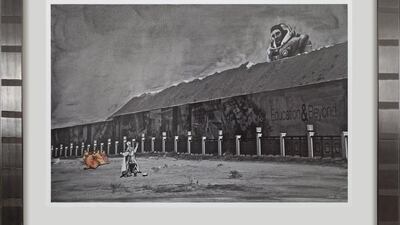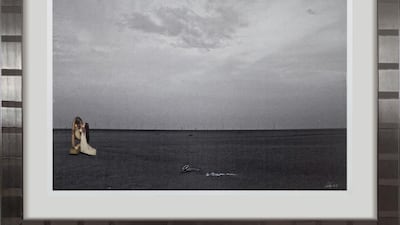For those of you not familiar with Shurooq Amin, allow me to make the briefest of introductions. This 47-year-old Kuwaiti artist, who has been painting and writing poetry for more than 20 years, is perhaps best known for having her 2012 Kuwait City exhibition, It's a Man's World, shut down within three hours for including "inappropriate" content.
But Amin takes it all in stride.
Her latest show, We'll Build This City on Art and Love, opened at Ayyam Gallery in Dubai International Financial Centre (DIFC) on Sunday, and although it still contains her trademark stamp of underlining double standards and pointing out contentious societal issues, it is, for the most part, a lot more hopeful than previous shows.
“This time I am talking about construction and rebuilding and starting fresh,” she says. “I have used flowers as a motif in many of the paintings and they represent hope, the possibility of something yet to bloom.”
Amin, who is as outspoken in real life as her paintings suggest, relies on portraits to get her message across. Her controversial portrayals of Arab men that were banned in 2012 and her subsequent 2013 show Popcornographic, focusing on women, were critical of Arab society in general. All of her characters were painted faceless or wore white masks as a way to cover their individual identity.
This exhibition is no different, but this time her characters are more nuanced. Firstly, the white masks have largely been replaced with flowers and, secondly, rather than be consigned to a miserable fate, their future seems brighter.
Take This Way Up: Painting the Roses Red as an example. In this painting, a mother, who is wearing a hijab and representing a more conservative sector of society, has her hand on her son's head and is, literally and metaphorically, opening his eyes.
“This one represents the entire series,” says Amin. “Because what I am saying is that you can be a traditional society and still raise open-minded children. The two things are not contradictory to each other.”
The portraits that populate the gallery are all based on people from Amin’s community who sat for her. It is because of this and the incredibly realistic rendering that they are easy to connect with.
A personal favourite is See the Beauty Here, where a young man wears a dishdasha and a baseball cap, and his hand is covered in tattoos. His inner conflict is palpable as he straddles the gulf between East and West.
Amin puts it succinctly: “There is a paradoxical struggle within kids these days and it is not their fault. They go to cinemas where extreme violence is allowed but a kiss is not. We are subconsciously telling them that violence is OK but love is not – it is very conflicting.”
Across the gallery is Fashionista, also known as The Mad Hattress, depicting a woman who has been paralysed by the fashion industry and whose high-heel-clad legs are supported by crutches because she has lost her sense of self.
“By allowing society to dictate to her, she has become handicapped. She has become a doll-like image of herself,” says Amin.
Alongside the portraits hang paintings of scenes in which Amin's characters have shrunk, much like the heroine of Alice in Wonderland, the children's book from which she took all of the paintings' titles.
The largest of these is a 4.6-metre canvas depicting a keyboard upon which her characters dance. There’s a woman in Islamic clothing jumping, a girl in a miniskirt and a man in Khaleeji dress playing the guitar as children bounce on the keys.
The entire image shows people having fun, but the sting comes in the title: Mara7 7aram. The Arabic words are mirror images that translate into "Fun" and "Forbidden", an acerbic comparison.
“This is the happiest painting but it is also the most sarcastic,” says Amin. “Allowing someone to have fun should not be wrong, but it is seen that way in our society.”
The final three pieces are photographic collages of construction sites in Kuwait that have been thwarted in their progress due to corruption. Executed with her usual dry humour and wit, the photographs add a different dimension to the paintings and, in fact, were only presented as photographs because of a flood in her studio that ruined the originals.
Despite having a more positive undertone, one of her pieces, The King of Hearts, which addresses love and marriage in Arab society, did not make the cut.
“I think my work is resisted because it is truthful,” says Amin. “I am holding up a mirror and showing problems we have in our society, but it has to be said that I really love my country and my region. I love being an Arab and I believe that we will rise up again as a civilisation. But that will never happen if we continue to hide our issues under the table.
“We have to bring things up to the surface and address them because this is the only way to find solutions. When we find solutions, then change is possible. And when change happens, that is when you create progress.”
• We’ll Build This City on Art and Love runs until October 23 at Ayyam, DIFC. For more information visit www.ayyamgallery.com
aseaman@thenational.ae

